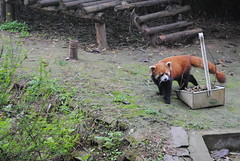
While seeing pandas in China was without a doubt a priority for me when I moved to the Middle Kingdom in late 2009, I really have my Aussie friend Dan to thank for my having seen them when I was there.
See, Dan had been absolutely adamant that we had to devote at least a few days of the two weeks he planned to spend in China in southwestern Sichuan province, home not only to pandas but to world-famous spicy food — more on that later. The bottom line is this: If you want to see pandas in China, and lots of them, your surest bet is visiting the official panda breeding and research center near Chengdu.

Artwork at the Panda Base depicts the fierce pandas of yesteryear
The Sad Story of the Panda
With all this talking panda “bases” and “breeding centers,” you’re probably wondering: Why can’t I just see pandas in the wild when I’m China? The short answer is that, for all intents and purposes, there aren’t any.
See, the panda has had an extremely unlucky history. Although it originated as a fierce, carnivorous predator in prehistoric times, it slowly evolved into a docile, vegetarian animal over the eons. Which would’ve been fine enough had the Chinese not come along, at which point pandas became increasingly restricted in terms of where they could live. This geographical confinement led the cruelty-free ursine to a diet that was not only vegetarian, but composed entirely of a specific species of bamboo, whose presence and quality also began to shrink thanks to the encroachment of the Chinese.

What pandas in China look like today.
To make matters worse, this fiber-rich, nutrient poor diet weakened both the panda’s digestive system and its metabolism, which is the reason the animals move sluggishly — it isn’t to be cute, in spite of how cute it makes them appear. They can also mate only once per year if they’re lucky and frequently miscarry, hence their plummeting numbers.
The final nail in the coffin of wild pandas in China was the 2008 Sichuan earthquake. The earthquake destroyed most of what was left of the panda’s natural habitat, which has thankfully been reconstructed at the Chengdu panda base, now understandably almost the only place to see pandas in China.

The morning panda feeding session.
Inside the Chengdy Panda Base
Once you enter the Chengdu Panda Base, for which there is a 50 yuan fee, you will find the panda museum and information center on the left side of the main road. Here, you can explore the long history of the panda in greater detail than the sob story I dictated above.
After you finish at the museum, you begin walking through the base’s massive 260-acre footprint, which is home to 83 giant pandas as of January 2012, who range in age from newborns to old timers. If you arrive early enough in the morning (I would suggest getting to the base no later than 8), you can view a live morning feeding session, which is one of the coolest things I’ve seen.

Staff at the Chengdu Panda Base have gone to great lengths to reconstruct the habitat of pandas in China.
Apart from the feeding, the number of pandas you see at the base really depends on luck. If the pandas are tired, the weather is poor or your timing just happens to be off, you might not see any pandas at all. During the first hour or so of the three I spent at the base, I didn’t see many pandas roaming among the reconstructed panda habitat, but the pandas thankfully became greater in number as the day progressed.

The adorable red panda, or 小熊猫.
Panda Extras at the Panda Base
For fees that seem to change at the whim of individual base employees, you can pose for photos with pandas or even get up close and personal with baby pandas, if there are any. I obviously didn’t take advantage of this offer, given my fear of being hustled in third world countries.
Although the standard giant panda (大熊猫 or da xiong mao, literally “big bear cat” in Mandarin) is without a doubt the star of the show at the Chengdu Panda Base, you’re also likely to see smaller red pandas, appropriately named xiao xiong mao (小熊猫) or “small bear cat.”

It’s definitely going to be an uphill climb for pandas in China.
Getting to the Chengdu Panda Base
The Chengdu Panda Base is located in Chengdu’s northern suburbs. Although it is possible to use Chengdu’s public bus system to reach the panda base, it is far easier to just take a taxi from your hotel or hostel, such as Sim’s Cosy Garden Hostel, particularly if you’re traveling with several people.
I absolutely recommend you visit the Chengdu Panda Base, although I imagine that doing so will make you quite sad, as it made me — the panda seems to be near the end of its lifespan as a species, in spite of humanity’s valiant efforts to save it. For more information about seeing pandas in China at the Chengdu Panda Base, visit the base’s official website.

Robert Schrader is a travel writer and photographer who’s been roaming the world independently since 2005, writing for publications such as “CNNGo” and “Shanghaiist” along the way. His blog, Leave Your Daily Hell, provides a mix of travel advice, destination guides and personal essays covering the more esoteric aspects of life as a traveler.








